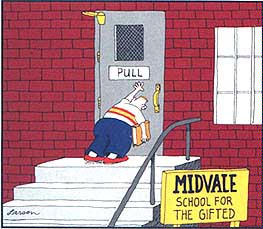|

What is Chemistry? (9/10/15)
What are some properties that can distinguish matter?(9/11/15)
What are the changes that matter can undergo? (9/16/15)
What are elements & how do they differ (9/17/15)
How can we distinguish metals from nonmetals? (9/18/15)
How can we tell if a substance is a compound? (9/22/15)
How do compounds differ from mixtures? (9/25/15)
What are some more methods for separating mixtures? (9/29/15)
Exam 1 Sample Test Answers (9/30/15)
Exam 1 Sample Test Part 2 Answers (9/30/15)
What are some more methods for separating mixtures? (10/2/15)
What determines the state of matter? (10/6/15)
How do we use the metric system? (10/7/15)
What is density and how does it relate to the 3 states of matter? (10/8/15)
How do we measure precisely? (10/9/15)
How do we calculate precisely? (10/15/15)
Answers to sample test explained (10/16/15)
What is the nature of temperature? (10/21/15)
How is quantity of heat measured? (10/23/15)
What does a heating curve show us? (10/26/15)
How do we solve Heating Curve questions? Answers to handout covered in class(10/27/15)
How do we calculate the q of a phase change? (10/28/15)
Energy Sample Test Explained (10/30/15)
Did_You_Get_IT?? (10/30/15)
Boyle's Law (11/04/15)
Lussac's Law (11/06/15)
Charles' Law (11/09/15)
Combined Gas Law (11/10/15)
Notes on Liquid Nitrogen LAB (11/12/15)
What makes a gas behave ideally? (11/13/15)
What is atmospheric pressure & how is it measured? (11/17/15)
What is the nature of liquids? (11/18/15)
Which factors determine the BP of a liquid? (11/19/15)
SLG_test_sample_ans (11/23/15)
LAB: Cooling Curve (11/25/15)
How do we find the "pen" for an atom of an element? (11/30 to 12/1)
How do we solve "pen" questions? Answers to HW questions
How was the structure of an atom discovered? (12/02/15)
AS Day2a (12/03/15)
How do we draw the Bohr Model of any atom?(12/08/15)
IONS & ORBITALS (12/09/15)
Answers to AS sample test explained (12/10/15)
What is the nature of radioactivity?(12/11/15)
How do we write nuclear equations? (12/14/15)
Uses & Risks of Radioactivity (12/15/15) - video presentation & notes.
How do we solve half-life problems? (12/16/15)
Half-life Day2 (12/17/15)
How is artificial radioactivity useful? (12/18/15)
Intro to PT (1/4/16)
Chemical Families of the Periodic Table (1/5 & 1/6/16)
What are the Periodic Trends? (1/7/16)
Periodic Trends Part 2 (1/8/16)
How can we predict which metal is more active? (1/11/16)
Final Review: Physical Behavior of Matter & Energy Filled Notes & Questions (1/13/16)
Final Review: Atomic Concepts Filled Notes & Questions (1/14/16)
Final Review: Nuclear Chem Filled Notes & Questions (1/15/16)
Final Review: Periodic Table Filled Notes & Questions (1/18/16)
RegChem 2 Notes Spr 2016
How do valence electrons affect the reactvity of an element? (2/2/16)
What happens when metals react with nonmetals? (2/3/16)
How do we draw the dot structures of ionic compounds? (2/4/16)
How do nonmetals bond with eachother? (2/5/16)
How do we draw the Lewis dot structures of molecules? Reviewing & Explaining HW#1 (2/9/16)
More practice drawing Lewis dot structures - covalent 2 classwork (2/9/16)
How do we name binary molecular (covalent) compounds? (2/10/16)
How does EN affect the character of a bond? (2/11/16)
How do we predict the 3D shape of a molecule? (2/12/16)
Going over answers to Last nite's HW on molecular geometry. (2/22/16)
What makes a molecule a dipole? (2/23/16)
How do molecules attract each other?(2/25/16)
What are the IMA's for nondipoles? (2/26/16)
What are the types of solids? (2/29/16)
How do we calculate the formula mass of a substance? (3/2/16)
How do we calculate the %composition by mass of a compound? (3/3/16)
What is the relationship between the EF & MF? (3/4/16)
How do chemists work with moles? (3/8/16)
HOLEY MOLEY 2 Activity (3/9/16)
How do we balance chemical equations? (3/10/16)
answers explained to math sample test (3/14/16)
How do we solve mole-mole problems? (3/15/16)
How do salts get dissolved? (3/16/16)
What factors affect solubility? Part1 (3/17/12)
What factors affect solubility? Part2 (3/18/16)
How do we solve solubility curve problems? (3/22/16)
How do chemists specify concentration? (3/23/16)
What are some other was of specifying concentration? (3/24/16)
Answers to Solutions Sample Test Explained (3/28/16)
What factors affect reaction rate? Part 1 (3/30/16)
What factors affect reaction rate? Part 2 (3/31/16)
How do chemists picture energy relationships in a chemical reaction? (4/1/16)
Answers to PE Diag1 HW (4/4/16)
What factors affect reaction rate? Part 3 (4/4/16)
How do we solve PE Diagram questions? (4/5/16)
IN CLASS READING: SUGAR FACTORY EXPLOSION (4/6/16)
How does equilibrium apply to chemistry? (4/12/16)
How do we shift an equilibrium point? (4/13/16)
Shifting Equilibria Day 2 (4/14/16)
Answers to HW#33 shift 2 multiple choice (4/15/16)
What makes a reaction spontaneous? (4/15/16)
Kinetics & Equilibrium sample test explained (4/18/16)
Why do some solutions conduct electricity? (4/20/16)
How do we explain the behavior of acids? (4/21/16)
How do we explain the behavior of bases? (5/3/16)
What is the basis of the pH scale? (5/5/16)
How do bases neutralize acids? (5/6/16)
Answers to Neutralization HW#41
How do we perform an A/B Titration? (5/9/16)
How does the alternate theory explain A/B behavior? (5/10/16)
A/B sample test explained (5/11/16)
A/B Sample Test Part 2 Answer (5/11/16)
What is the meaning of oxidation? (5/12/16)
Redox1 HW answers explained (5/12/16)
How do we determine the oxidation number (state) of an element? (5/12/16)
How can we obtain useful electricity from a spontaneous redox reaction? Voltaic Cell 1 (5/13/16)
How do turn a redox reaction into a voltaic cell? (5/17/16)
How can we force a nonspontaneous redox reaction to occur? Electrolytic Cell (5/17/16)
Redox sample test explained (5/18/16)
Orgo1:HYDROCARBONS (5/23/16)
Orgo2: ISOMERS (5/24/16)
Orgo3: FUNCTIONAL GRPS (5/25/16)
Orgo4: Reactions (5/26/16)
Solving Problems by Using the Reference Tables Part 1 (5/31/16)
Enter subhead content here
|
